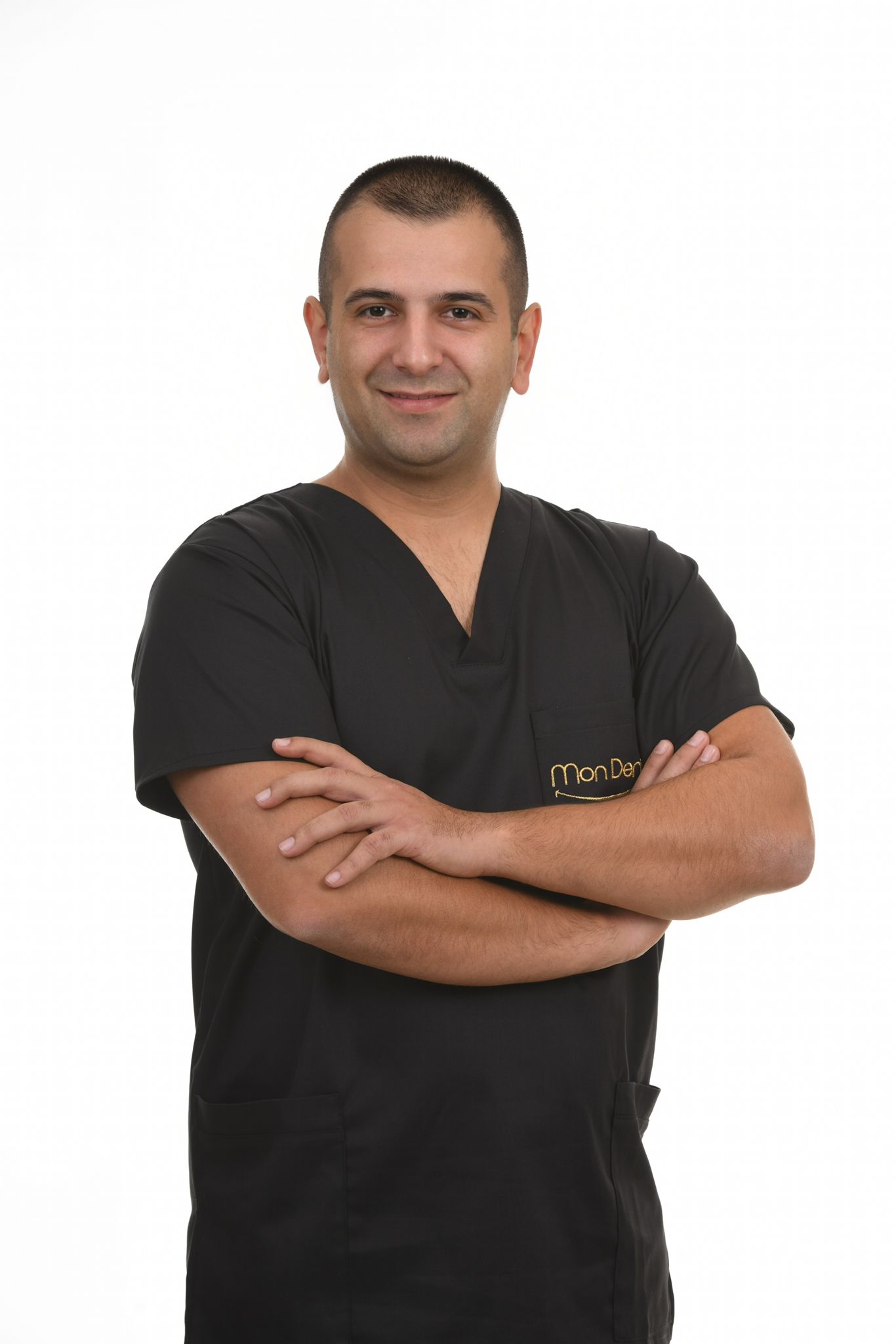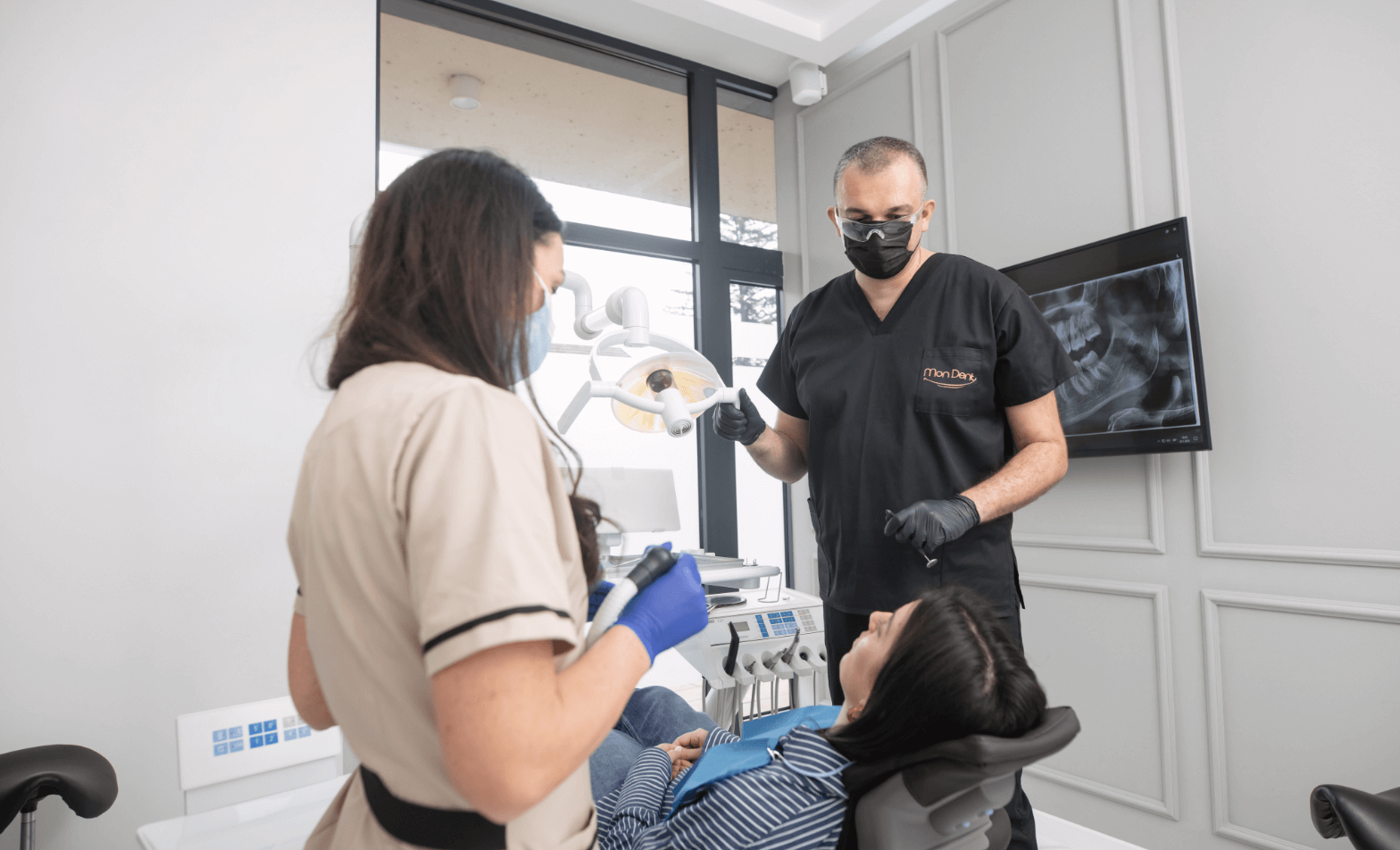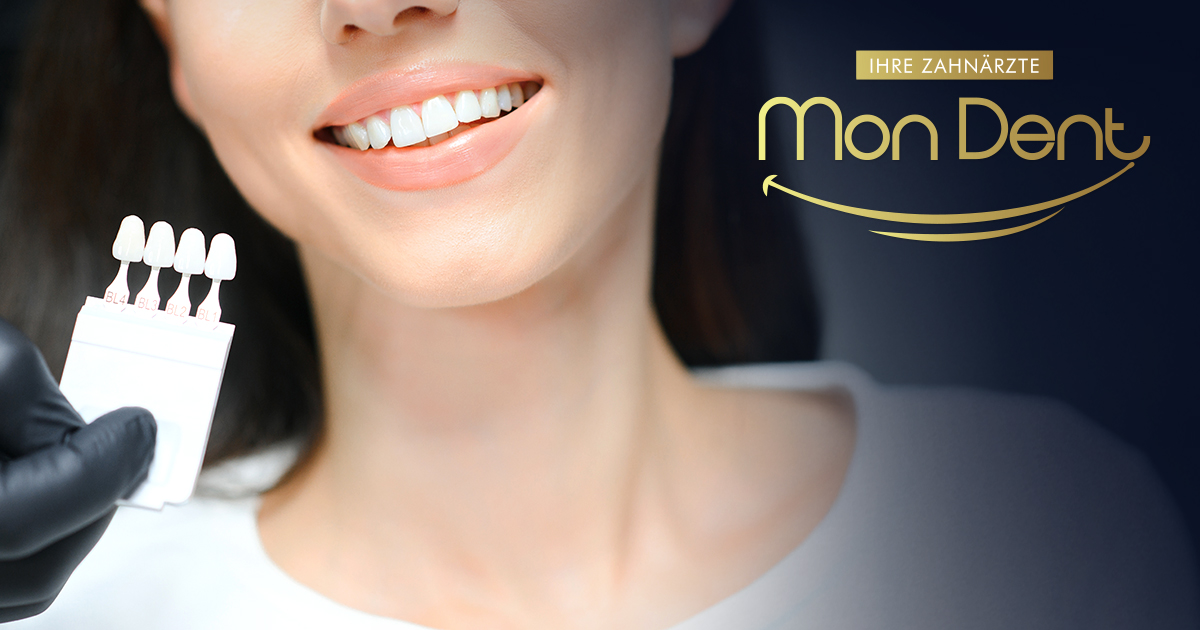Content:
- Causes of darkening and yellowing of teeth
- How to prevent teeth darkening
- Methods of teeth whitening at home
- Professional teeth whitening at the dentist
- Teeth whitening Zoom lamp
- Conclusion
Teeth whitening is one of the most sought-after cosmetic dental procedures today – and for good reason. We all want to confidently show off a sparkling white smile. Unfortunately, teeth naturally darken with age, and habits like drinking coffee or smoking can accelerate the appearance of yellow shades.
The good news is that there are effective solutions! Before you decide to whiten your teeth, you need to know the causes of tooth discoloration and how to prevent staining. Then, we'll show you our tips for at-home teeth whitening as well as our suggestions for when to visit your dentist.
We visited a special focus Zoom teeth whitening lamps – the modern technology used by our dental office MonDent, with review teeth whitening prices and the benefits it brings. Read on and find out how to restore the shine to your smile in a safe and effective way!
Causes of darkening and yellowing of teeth
It is important for us to first educate you and explain why the loss of natural tooth whiteness occurs in the first place. Over time, a combination of our habits, diet, and biology can cause tooth stainingWe're sure that most of you already know what the most common causes of tooth discoloration are, but there are also some reasons that will surely surprise you.
At our dental office, MonDent, we always want to emphasize the importance of maintaining and preventing dental health, and we always provide our patients with useful advice and guidelines.
- Food and drink – Beverages like coffee, black tea, red wine, and cola drinks contain dark pigments (tannins) that deposit on tooth enamel. So, in addition to being unhealthy for your body, these foods also contribute to the darkening of your teeth.
- Smoking – Nicotine and tobacco tar are the main culprits for the yellowish-brown coating on smokers' teeth. Long-time smokers notice significantly darker teeth, as these substances penetrate the enamel and change its color. Even e-cigarettes harm the appearance and health of your teethIf you are a smoker, do you remember what your teeth were like before you started smoking and what they are like today?
- Insufficient oral hygiene – If teeth are not brushed and flossed regularly, plaque builds up on them and hardens into tartar. This deposit is yellowish in color and makes teeth darker, and can also bind pigments from food.
- Aging – As we age, our tooth enamel (the white, outer layer of our teeth) naturally wears away and thins. As the enamel thins, the inner layer of dentin, which is yellowish in color, becomes more visible. The result is darker, yellower teeth in older people, even with good hygiene. There is not much you can do about this, except to visit your dentist and ask about dental teeth whitening methods.
- Genetics – Some people simply have a genetically determined tooth shade that can be darker. The thickness of the enamel and the natural color of the dentin vary from person to person. If your parents have yellow teeth, it is possible that you will be prone to it too, regardless of your habits.
- Medications and health conditions – Certain antibiotics (such as tetracycline) can cause permanent grayish or yellowish discoloration of teeth if taken during tooth development (in childhood). Also, excessive use of fluoride during childhood can lead to fluorosis, the appearance of white or brown spots on the teeth. In addition, diseases that affect tooth enamel or treatments such as chemotherapy can cause changes in tooth color.
- Dental injuries – Impacts and injuries can damage the dental pulp (nerve) inside the tooth, sometimes leading to darkening of the affected tooth. While this is not a common cause of generalized yellowing, a single darkened tooth can detract from the overall whiteness of your smile.
All of these factors contribute to the loss of shine in teeth. Fortunately, many of them can be controlled or mitigated with proper care and habits.
How to prevent tooth disease and discoloration
Preventing yellow or dark teeth is often easier (and cheaper) than whitening them later. By adopting healthy habits, we can significantly slow down the process of tooth darkening.
The MonDent team brings you several practical tips on how to keep your teeth white for as long as possible:
- Regular and thorough oral hygiene
The foundation of a beautiful smile is good hygiene. Brush your teeth at least twice a day with a good quality toothpaste (preferably with fluoride) and a soft toothbrush. Don't forget to clean between your teeth with dental floss or interdental brushes once a day. These habits remove plaque before it turns into tartar and prevent the buildup of surface stains. You can also use a whitening toothpaste occasionally to help remove new discolorations (more on such toothpastes later).
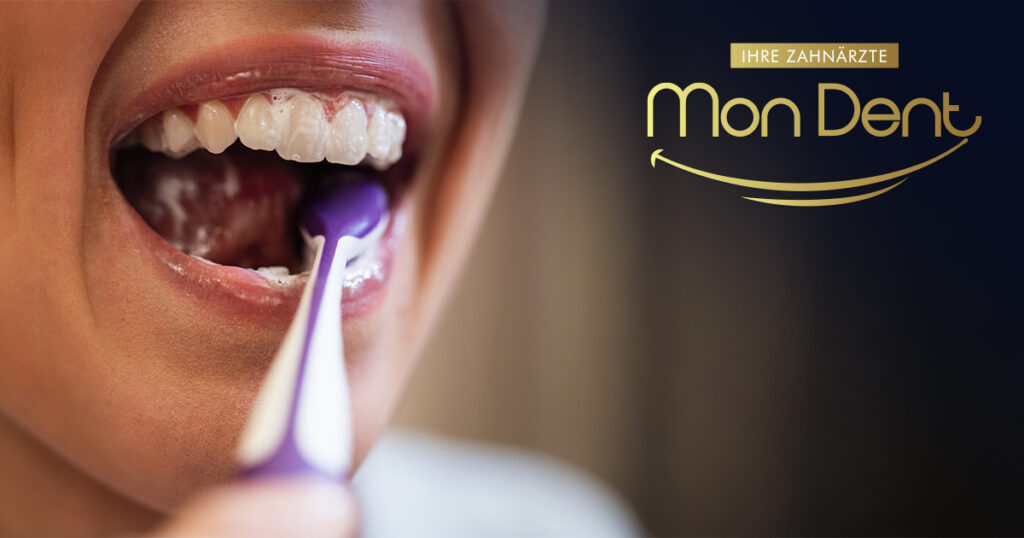
- Reduce your intake of drinks and foods that stain teeth.
Coffee, black tea, red wine, and dark juices are the most common culprits for staining your teeth. We don't suggest giving them up completely, but try to limit their consumption. Also, after drinking such drinks or eating colored foods, rinse your mouth with water. This will remove some of the pigments before they can bond to your teeth. If possible, brush your teeth with a toothbrush and toothpaste after consuming these foods.
- Smart consumption habits
There's one trick that many people won't tell you, and that's to use a straw when drinking drinks that can damage your teeth. The straw will reduce the contact of the liquid with your teeth, thus reducing stains.
- Regular professional teeth cleaning
Even the most dedicated home hygiene cannot completely prevent tartar buildup. So visit your dentist every 6 months for a check-up and teeth cleaning. Dental cleaning (ultrasound scaling and “sandblasting” teeth polishing) will remove stubborn plaque and many surface stains. After a professional cleaning, your teeth will immediately look brighter.
If you follow these tips, your teeth whitening may not be necessary for a long time. Even if you decide to have a whitening treatment, adopting these habits will help the results last longer. Healthy habits preserve not only the color, but also your overall oral health – and a healthy, well-groomed smile always looks better!
Methods of teeth whitening at home
When you notice that your teeth have lost their shine, the first step is usually to try one of the at-home whitening methods available. There is a whole range of products and DIY tricks that promise whiter teeth.
Home treatments are generally affordable and easy to apply, but it's important to have realistic expectations - they can usually remove surface stains and lighten your teeth a shade or two. Below are some of the most popular at-home teeth whitening methods:
Whitening toothpastes
There are many toothpastes on the market labeled as “whitening” or bleaching toothpastes. These toothpastes usually contain mild abrasive particles (such as silica) that help polish teeth and remove surface stains from food and drinks. Some toothpastes also have chemical ingredients like low levels of hydrogen peroxide or enzymes that dissolve pigments. By using such toothpastes regularly, you can keep your teeth brighter and prevent new yellowing from occurring.
Important: Whitening toothpastes cannot change the natural color of the dentin beneath the enamel, so don't expect them to drastically change the shade, but they can remove mild discolorations and restore your teeth to their natural shine.
Teeth whitening strips and gels
For a more visible whitening effect at home, popular choices are: whitening strips. These are thin, flexible strips coated with a gel containing a whitening agent (usually carbamide peroxide or hydrogen peroxide in low concentration). The strips are stuck directly to the teeth and left on for a certain period of time (usually 20-30 minutes a day, for ten to fifteen days, depending on the product). Through regular use during this period, teeth can lighten by several shades. The strips are relatively safe if used as directed, but they may cause temporary tooth sensitivity or gum irritation if the recommended time or frequency of use is exceeded.
Remark: When using strips, gels, or any at-home teeth whitening products, always follow the manufacturer's instructions. More is not always better—leaving the gel on longer or using it more often than recommended will not speed up the process and may damage your enamel or gums. Also, these methods do not whiten fillings, crowns, or veneers on your teeth—they only work on natural tooth enamel.
Natural ways for whiter teeth
The Internet and people's councils are full of so-called natural whitening methods that you can try at home with ingredients from your kitchen. Although many people claim that these tricks have helped them, their effect is generally limited, and they should be used with caution to avoid damaging your teeth. Here are some of the most popular DIY methods:
Baking soda (sodium bicarbonate) It is a mild abrasive and is often mentioned as a whitening agent. However, be careful: due to its abrasiveness, it is not recommended to use baking soda too often (maximum once a week) to avoid wearing down the enamel.
Usage coconut oil (oil pulling) has become quite a trend in recent years. Proponents claim that coconut oil draws out bacteria and dirt from the oral cavity, thus helping to keep teeth whiter. It is true that oil pulling can improve gum health and reduce bacterial deposits, but, Oil alone will not significantly whiten teeth because it contains nothing that would bleach stains (no acid or peroxide).
Avoid aggressive "do it yourself" methods
In addition to the above, you can find advice on the internet such as rubbing your teeth with lemon, vinegar, activated charcoal, etc. As experienced dentists, we advise you to avoid using citric acid and vinegar because it can cause serious damage to the enamel.
Activated charcoal, present in some toothpastes and powders, is very abrasive: it ostensibly whitens teeth by removing stains, but in fact it scratches the enamel surface, leaving it rough (which can lead to even more stain buildup in the long run!). In short, natural methods can be fun and somewhat beneficial, but always use them with caution and moderation.
Professional teeth whitening at the dentist
Professional whitening, or teeth whitening at the dentist, is the safest and most effective way to get noticeably whiter teeth. Dentists have the strongest whitening agents and the expertise to make the procedure as effective as possible. safe for your teeth and gums.
Unlike home remedies, which mainly target surface stains, professional treatments can whiten deeper layers of your teeth. Here are some options available in dental offices:
1. In-office teeth whitening (outpatient whitening): This procedure takes place in the dentist's chair and usually takes about 1 hour. Before the whitening procedure, the dentist will examine your teeth and gums to make sure there are no cavities, gingivitis, or other problems that need to be addressed before treatment.
2. Home whitening under the supervision of a dentist (individual splints): Another option that the dental office can offer is to make you personalized splints (similar to mouth guards) and provide a professional whitening gel that you can apply yourself at home.
The advantage of this method is that you whiten your teeth gradually and you can control the pace – if sensitivity occurs, take a break for a day or two and then continue. The final result after a complete treatment can be comparable to outpatient whitening, only it is achieved more slowly.
Professional teeth whitening has a number of advantages over trying it yourself at home. First, there is expert supervision – the dentist will choose the appropriate method and gel concentration for your teeth, making sure that the procedure is safe.
Gums and other tissues are protected, which minimizes the risk of irritation. Second, the results are more pronounced and lasting; the agents used by dentists are stronger than anything allowed over the counter, so they can remove even deep stains that have accumulated over the years.
Third, you will get professional advice how to maintain your new white teeth – from recommendations for toothpastes to reduce sensitivity to advice on diet after whitening (e.g., it is advisable to avoid strongly colored foods for the first 48 hours while the color "stabilizes").
In addition to all these methods, there is one of the most modern methods of professional whitening - Zoom system, which we also use in our office, so you can understand how it works and what benefits it provides.
Teeth whitening with Zoom lamp
Among modern whitening techniques, Zoom teeth whitening stands out for its efficiency and popularity. It is a technology developed by Philips (also known as Philips Zoom! whitening) and is used worldwide in dental clinics to quickly achieve brilliantly white teeth. The procedure is actually a type of outpatient whitening, but with the use of a specially designed high-intensity Zoom lamp that speeds up the whole process and gives maximum results in a short time.
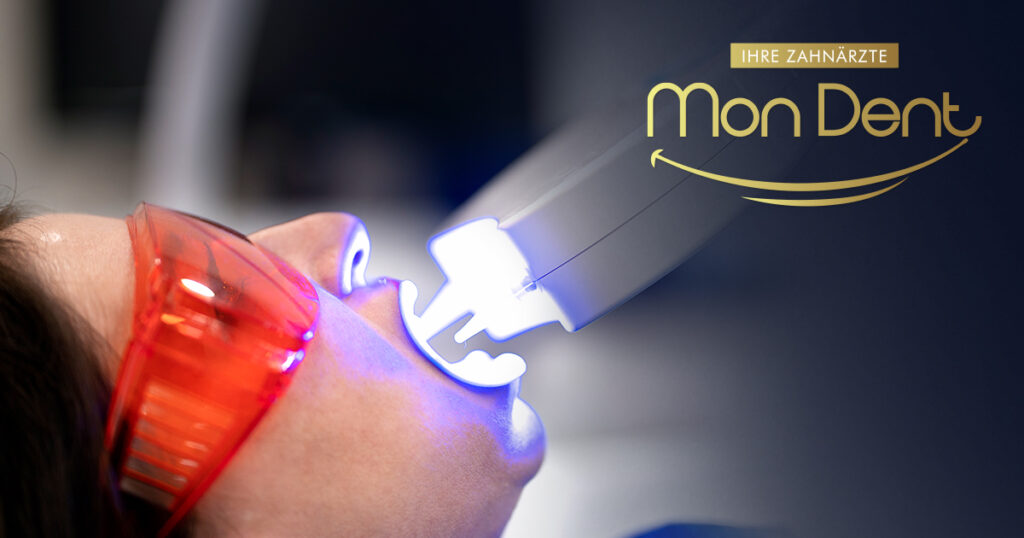
How does the Zoom method work?
After the gums are protected, the dentist applies Zoom whitening gel to the teeth. This gel contains a high percentage of hydrogen peroxide, which is the active whitening ingredient. Then, the Zoom lamp – a special lamp that emits light of a certain wavelength (in the blue spectrum).
The light from the lamp activates the gel on the teeth, helping the peroxide release oxygen molecules more quickly. These molecules penetrate the tooth enamel and break down the pigment molecules that cause staining. Zoom treatment is typically performed in 3 cycles of 15 minutes each during one session. This means that the total active whitening time is about 45 minutes (not counting preparation). In those 45 minutes, an extremely visible change is achieved – teeth can be lightened up to 8 shades in relation to the initial state.
It is important to emphasize that this treatment is completely painless and that you will enjoy the procedure. The only thing that some patients feel is an occasional mild tingling or sensitivity in the teeth during or immediately after treatment.
After the treatment is complete, you will be advised to avoid highly colored foods and drinks for the first day or two (the so-called "white diet" for 48 hours) while the color stabilizes - this means, for example, choosing milk or water instead of coffee, white wine instead of red wine, etc., so that newly whitened teeth do not immediately become discolored by pigments while they are temporarily a little more porous.
Zoom at MonDent office
As a modern dental practice that follows innovations, MonDent has also introduced into its offer: Zoom lamp whitening precisely because of its proven results. We believe that our patients deserve the most modern treatments, which is why we constantly invest in modern equipment and education.
Zoom technology allows us to During just one visit, we provide the patient with a dramatic change in their smile, which was not previously possible without multiple arrivals. This system is safe for tooth enamel, and our dentists apply it precisely and carefully so that each patient gets the optimal result.
As part of the services we provide in the field of cosmetic dentistry, teeth whitening with the Zoom lamp holds a special place. Our satisfied patients testify to how their teeth have become dazzlingly white and up to several shades lighter, restoring their confidence in their smile.
Price of teeth whitening with Zoom lamp
You are probably wondering too How much does teeth whitening cost? This advanced method. Teeth whitening with the Zoom lamp is among the top aesthetic treatments on offer, but it is affordable considering the results and duration of the effect.
According to our price list, the price of Zoom teeth whitening at MonDent is 500 KM for the complete treatment. This price includes the examination and consultation before the procedure, the whitening procedure of all teeth in one session, as well as the final fluoridation treatments after whitening. No hidden costs – you receive professional service using original Philips Zoom technology, which guarantees quality.
When you think about teeth whitening price In the context of at-home versus professional methods, also keep in mind the value you're getting. Strips and at-home gels may be cheaper per treatment, but they often require long-term and repeated use to achieve limited results. On the other hand, Zoom professional whitening offers maximum visible result in minimum time, under the supervision of experts.
Conclusion
Yellow or dark teeth can be a drag on your self-confidence, but with today's methods, it really doesn't have to be a permanent condition. The key is to choose an option that is best for your teeth and your wishes. Remember that dental health comes first – it is always recommended to consult a dentist before embarking on any serious whitening, to ensure that the tooth tissue is healthy and that you choose a method that will give the desired effect without any unwanted consequences.
At MonDent Dental Clinic, we are at your disposal for all your questions and concerns regarding whitening and cosmetic procedures. Our experienced team will examine the condition of your teeth, listen to your wishes, and advise you on the best way to make your smile shine.
Contact us for free consultation. and find out how we can help you achieve the smile you've always dreamed of. Your teeth deserve the best care, and you deserve to smile with all your might!

